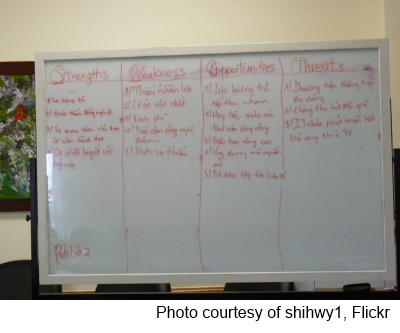If you own a seasonal green industry business, you probably can’t wait for the offseason. It gives you time to relax after a long, hard busy season. But it also gives you an opportunity to reassess your business, figure out what is working and what isn’t, and improve your business so you’re set up for success during the next busy season.
So what should you do to assess your business? There are a large number of things you can do to get yourself ready for the next year, but here are five good places to start:
- Do a SWOT Analysis – You can’t improve if you aren’t honest about your business. So I always start my offseason preparation with a SWOT analysis to determine what my business strengths, weaknesses, opportunities and threats are. It helps me get in the right frame of mind and I can be laser focused on what I need to improve in the offseason.
I find it helps to get input from my key employees for the SWOT analysis, so I typically bring together all of my direct reports and brainstorm items for the lists. Oftentimes, they’ll identify strengths and weaknesses that I’d have never considered.
- Identify Issues within your Business – After you’ve done a SWOT analysis, it’s time to develop a list of issues within your business. Do you have aging equipment? Is the paperwork in your business killing growth and can field service software eliminate it? Why are you losing customers? Is there an opportunity to add another service, like snow removal? Look at everything on your SWOT analysis list and starting figuring out what issues your business has. Then, rank them in the order in which you’d like to solve them.
- Create 1 Year Goals – Once I’ve done my SWOT analysis and identified issues, it’s time to create one year goals. I preach setting SMART goals – Specific, Measurable, Attainable, Relevant, Timely . For example, if you can’t measure a goal, then you have a hard time determining whether your goal was met or not. Likewise, setting a revenue goal without a deadline to reach that goal really isn’t a worthwhile exercise. So make sure your 1-year goals are SMART goals.
- Create an offseason calendar - I’m a big believer in creating an actionable plan. So I always start by writing down what I want to accomplish, determining how long each task will take, prioritizing them if I have a lot of things to accomplish, and then create a calendar and a timeline that helps me get done what I need to get done in the time that I have. Then, every morning I review my timeline to see what my projects for the day should be.
So in the offseason, I first determine what I need to do by conducting a SWOT analysis and create annual goals. Then, I turn those into an actionable plan by writing them on a calendar. You can go the old fashioned route and get yourself a calendar and write down items on that calendar. But I’m a new-fangled kind of guy, so I usually fire up Excel and create a nice timeline that helps me prioritize work. - Use email to keep in touch with customers and market your business – The first four items on this list are all about assessing your business and creating a plan. The last item has nothing to do with your plan, but as I talked to our customers about a new email product we’re releasing – HindSite Connect – it hit me: Service businesses aren’t leveraging the power of email to generate business in the offseason.
I’ve heard it many times in conversations with customers: I can’t use email in the offseason. My first question is “Why not?” Just because you aren’t working, doesn’t mean you can’t use email to communicate with your customers and prospects. Email is an inexpensive service business marketing tactic. Use it to send out contract renewal notifications, send a holiday email promoting your service business, use it to promote a new service you plan to offer in the spring, send out a monthly newsletter. There are a large number of ways you can leverage email to communicate with your customers, and when you aren’t busy servicing their property is the perfect time to do it.
You definitely need to get some rest and relaxation in the offseason. But if that’s all you focus on, you’ll find that by the time the snow starts to melt and the ground thaws, you’re already behind for the following year. So be sure to spend time early in the offseason – as early as you can since the pain you felt during the busy season will still be fresh in your mind – planning how to grow and improve your business.
Need some more offseason tips? Check out our free eBook, 10 Ways to Improve Your Business in the Offseason, for some more great tips.







